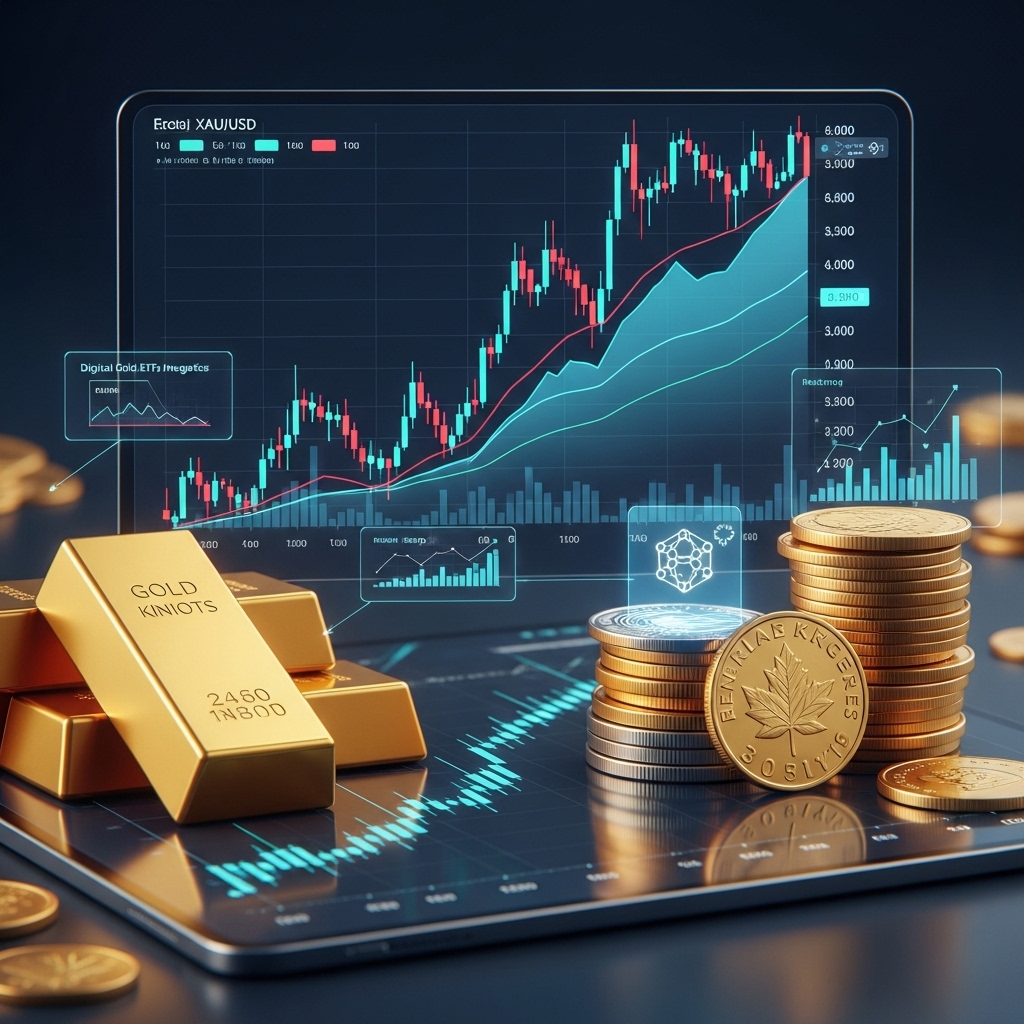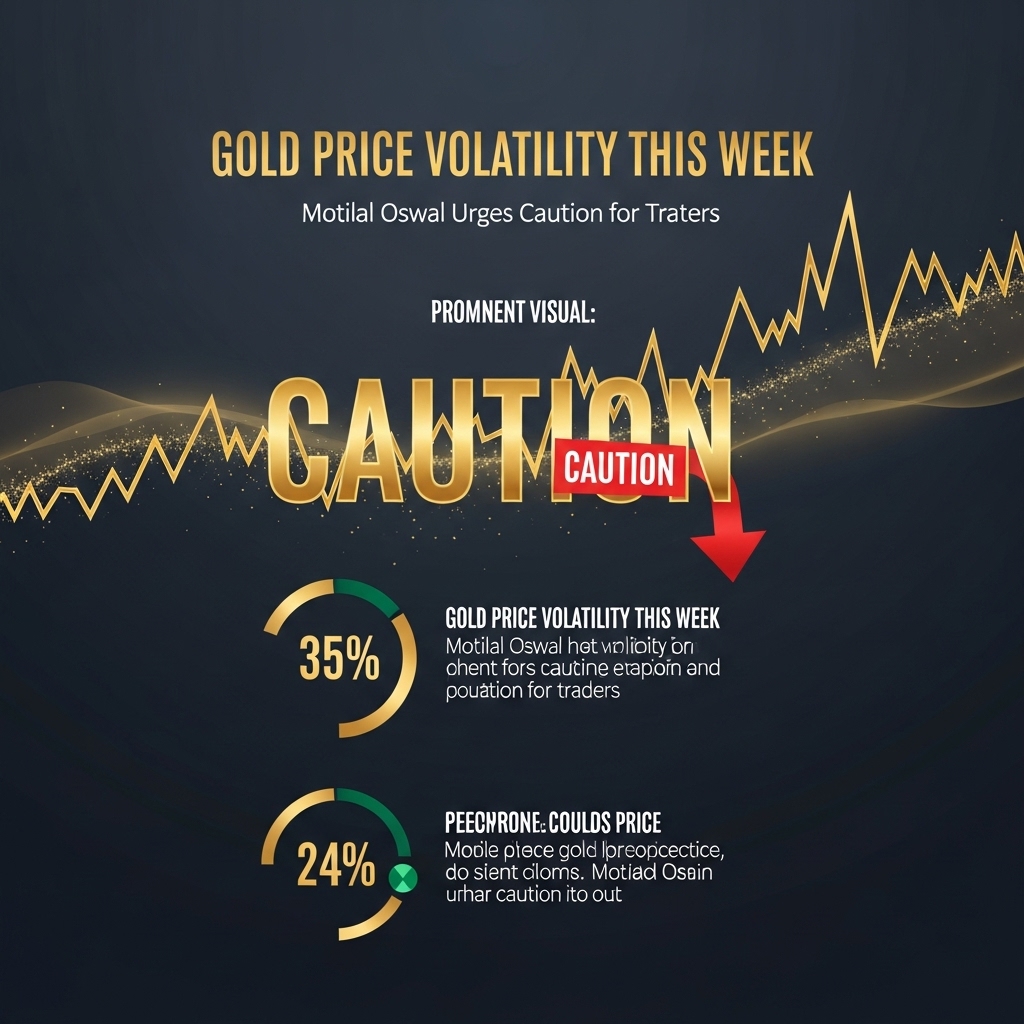Navigating the Golden Roller Coaster: Why Caution is Key for Gold Investors
Gold has long been revered as the ultimate safe haven, a beacon of stability amidst economic uncertainty and market turbulence. However, recent weeks have seen the precious metal embark on a particularly volatile journey, leaving many investors questioning their next move. Far from its typically serene trajectory, gold prices have experienced significant swings, presenting both potential opportunities and considerable risks. This dynamic market environment underscores the critical importance of staying informed and adopting a prudent approach, especially for those actively engaged in gold trading and investing.
This blog post delves into the specifics of this week’s gold price volatility, unpacking the underlying factors contributing to these fluctuations. We’ll explore the market trends that are shaping gold’s current path and, crucially, highlight the recent advisories from financial experts like Motilal Oswal, who are urging caution for traders. Their insights provide a vital compass for navigating these choppy waters, helping investors understand the nuances of the current market landscape.
For every gold investor, whether you’re a seasoned trader or building a long-term portfolio, understanding market volatility isn’t merely academic; it’s fundamental to safeguarding your wealth and maximizing potential returns. This deep dive will equip you with a clearer perspective on the risks involved, help you identify strategic entry and exit points, and ultimately empower you to make more informed decisions. In a market where precision can make all the difference, grasping these insights is key to leveraging gold’s financial benefits while mitigating exposure to unexpected downturns.
Gold Market Analysis and Key Insights
This week’s significant gold price volatility, prompting caution from Motilal Oswal, highlights critical drivers for investors.
Geopolitical Tensions and Safe-Haven Demand
Global instability remains a primary catalyst. Conflicts and heightened tensions bolster gold’s safe-haven status, attracting investors seeking a reliable store of value. This provides a price floor but also contributes to sharp upward movements, underlining its role as a systemic hedge.
US Dollar Strength and Interest Rate Outlook
A strengthening US Dollar typically pressures gold downwards, making it more expensive. The Federal Reserve’s interest rate policy influences dollar strength. Higher rates make non-yielding gold less attractive versus interest-bearing alternatives, a crucial inverse relationship.
Central Bank Policies and Inflation Concerns
Central bank gold purchases signal sovereign confidence. Persistent global inflation concerns drive demand for gold as an inflation hedge. However, the balance between inflationary pressures and monetary tightening creates a complex, often volatile, environment for gold.
Current Gold Market Trends and Data:
Gold prices react acutely to US economic indicators like inflation and employment. While a long-term bullish narrative persists, short-term trading is marked by rapid swings. Motilal Oswal’s caution stems from these unpredictable fluctuations, advising extreme prudence.
Investment Benefits and Considerations:
For long-term investors, gold offers excellent portfolio diversification, an inflation hedge, and intrinsic value. It generally performs well when traditional markets face headwinds. Its non-yielding nature and price volatility require consideration. Short-term speculative trading carries substantial risk.
Expert Recommendations:
Motilal Oswal’s advice emphasizes a cautious, well-researched approach. For investors, dollar-cost averaging during dips can mitigate volatility. Long-term accumulation, not speculative day trading, is recommended to harness gold’s safe-haven and diversification benefits. Investors should closely monitor global economic and geopolitical developments.

Gold Investment Strategies and Options
Given the recent volatility in gold prices, adopting a well-thought-out investment strategy is paramount. Investors have several avenues to gain exposure to gold, each with distinct characteristics. Physical gold (bars, coins) offers direct ownership but entails storage and security concerns. Gold Exchange Traded Funds (ETFs) provide a cost-effective, liquid way to invest in paper gold, tracking the metal’s price without physical custody. Sovereign Gold Bonds (SGBs), issued by the government, offer a safe alternative with annual interest and tax benefits, though they come with a lock-in period. For experienced traders, gold futures and options allow leveraged bets on price movements but carry significantly higher risks.
Risk assessment and portfolio allocation are crucial. Gold typically serves as a hedge against inflation and economic uncertainty, not a primary growth asset. Experts often recommend allocating 5-15% of a diversified portfolio to gold, considering its non-yielding nature and susceptibility to currency fluctuations and interest rate changes. During periods of high volatility, a conservative allocation is advisable.
Comparing methods, physical gold appeals to traditionalists, while ETFs offer convenience and liquidity. SGBs provide safety and income, suitable for long-term investors. Market timing is particularly critical amidst current volatility. Motilal Oswal’s caution suggests avoiding speculative short-term entries. Instead, consider dollar-cost averaging for gradual accumulation or waiting for significant price corrections if conviction for gold’s long-term drivers (e.g., persistent inflation, geopolitical tensions) remains strong. Understanding macro-economic indicators, like interest rate outlooks and dollar strength, is vital before making investment decisions in such a dynamic environment.
Market Performance and Outlook
Gold’s historical performance showcases its enduring appeal as a safe-haven asset, frequently rallying during periods of economic uncertainty and inflation. After surging to record highs earlier in the year, driven by geopolitical tensions and inflation concerns, gold prices have recently entered a phase of heightened volatility. This week’s significant price swings underscore a market grappling with conflicting signals, compelling firms like Motilal Oswal to urge caution for traders.
Current market conditions are shaped by a delicate balance of economic factors. Stronger-than-expected economic data from key global economies, coupled with a persistent hawkish stance from major central banks on interest rates, is exerting downward pressure. Higher interest rates increase the opportunity cost of holding non-yielding gold, while a strengthening US Dollar also typically acts as a headwind. Conversely, ongoing geopolitical instability and lingering fears of a global economic slowdown provide underlying support, preventing a steeper decline.
Looking ahead, the future outlook for gold remains cautiously optimistic but fraught with near-term uncertainty. Critical economic factors influencing its trajectory include upcoming central bank monetary policy decisions, particularly from the Federal Reserve. A dovish pivot could reignite gold’s rally as real yields fall, while continued tightening could maintain pressure. The US Dollar’s strength, global economic growth patterns, and any escalation in international conflicts will also be pivotal in determining gold’s direction, suggesting continued price fluctuations for the foreseeable future.
Frequently Asked Questions About Gold Investment
1. Why is gold experiencing high volatility this week?
Gold prices are influenced by global economic data, central bank policies (especially interest rates), and geopolitical developments. Recent shifts in these factors, such as inflation concerns or fluctuating dollar strength, can lead to increased short-term volatility, prompting institutions like Motilal Oswal to advise caution.
2. What does Motilal Oswal’s urge for caution imply for traders?
It signifies an environment of heightened risk where prices can move sharply in either direction. For traders, this means exercising extra diligence, implementing stricter stop-losses, potentially reducing position sizes, and avoiding speculative moves without thorough analysis.
3. Is gold still considered a safe-haven asset amidst such volatility?
While gold traditionally acts as a safe haven during economic uncertainty and inflation, even safe havens can experience short-term price fluctuations. Its long-term role as a hedge against currency debasement and systemic risk typically remains, but immediate market movements can be unpredictable.
4. What key factors should investors monitor regarding gold prices?
Investors should closely watch the US dollar index, Federal Reserve interest rate decisions, global inflation data, geopolitical tensions, and crude oil prices. These macro-economic and geo-political factors are significant drivers of gold’s supply and demand dynamics.
5. Should I avoid investing in gold during periods of high volatility?
Not necessarily, but approach with a strategic mindset. Long-term investors might consider dollar-cost averaging to mitigate risk, while short-term traders should prioritize robust risk management and sound technical analysis. Diversification within a portfolio remains crucial.

Final Thoughts on Gold Investment
This week’s gold price volatility, as highlighted by Motilal Oswal’s advice, underscores the inherent risks in short-term trading. The key takeaway for investors is that while gold remains a valuable long-term asset and a hedge against economic uncertainty, impulsive decisions based on daily swings can be detrimental. Our final recommendation is to maintain a disciplined, long-term perspective, treating gold as a strategic portfolio diversifier rather than a speculative play.
Before making any investment moves, thoroughly research current market conditions and, most importantly, consult with a qualified financial advisor. This crucial step will ensure your gold investment strategy aligns perfectly with your individual financial goals and risk tolerance.